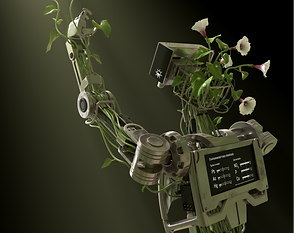
CYBORG BOTANY: MOCK MAGAZINE COVER

A mock journal cover for Scientific American, based on research done by Harpreet Sareen at MIT. This research was a design exploration where plants were interfaced with robots and computers. Plant light-sensing drove the motion of robots, plants were augmented to allow them to act as motion and chemical sensors, working circuitry was grown in stems, and more. This project allowed me to use visual metaphor to convey the ideas of the research.
Client: Prof. Marc Dryer
Media: Autodesk Maya, Adobe Photoshop, Adobe Illustrator
Format: Scientific magazine/journal cover
Audience: General audience
Date: December 2019
PROCESS WORK
The objective of this assignment was to create a striking magazine/journal cover primarily using 3D modelling in Maya. It was important to incorporate visual metaphor and work around the layout design conventions of the chosen publication. A good cover should be pleasing at first glance and grab a viewer’s attention, but also offer interesting details and deeper meaning when inspected further.
I found an MIT Master's project by Harpreet Sareen that explored interfacing between plants and robots/computers. The thesis was titled Cyborg Botany, which I found to be an attention-grabbing descriptor that evoked sci-fi imagery. I loved the idea of integrating organic life with technology, and thought it would provide some interesting visual contrasts in the piece, and give a lot of room for creativity.
IDEATION & THUMBNAILS



I began to ideate on the visual metaphors to be used. In the thesis, a number of interfaces were created: functioning ‘wires’ grown inside stems, plants were used as motion sensors and chemical sensors, and a wheeled robot was created that would move toward light based on the plant’s phototropism. These were the main elements I decided I could integrate in a rendered image.
The first two ideas focused on integrating a plant with a robot while referencing these interfaces. Each of these robots are reaching toward the light while holding a plant up to it. There are also light level indicators, to make this action clearer. This also allowed me to reference the idiom of 'shedding light' on something new. I took the idea of growing a conductor inside a stem further, and showed vines taking the place of wires in the robot. This gave extra meaning to the plant growing throughout it. In the first thumbnail, there are also concentrations of plants in the abdominal core and head of the robot. Its humanoid nature allowed me to use connotations to suggest that the plant is the 'core' or 'brains' of the robot, and is playing a part in driving it. There is also a sensory aspect: there are electrodes on the plant, and a chemical detection display.
The third idea was inspired by the notion of a cyborg in general: an organic lifeform with augmented mechanical parts. The concept had less references to the research, but was still visually interesting.
COMPREHENSIVE SKETCH

I chose to go forward with the humanoid robot, because of its emotionality and the additional references. I created a rough maquette as a perspective reference in the sketch, and to give me an accurate idea of how the final pose would look. Here, I decided to make it more mechanical, and referenced these types of robots for the design (including the terminator!). I thought about how the joints would move, and how the plant life would be made prominent within the machinery. I added details to get to a level of pleasing complexity, and to enhance the realistic feel of the design. For example, the small bands that tied together bundles of vines was meant to give the vine-wires a more intentional, organized feel.
MODELLING & RIGGING
I modeled pieces of the robot based on the proportions of the rough maquette. Most of the modelling was done in T-pose, and was rigged with a skeleton. Some of the mechanical design also became clearer during this process. The vines were created as curves, then bound to the same skeleton. After posing the robot, I extruded along these curves to make them into polygon surfaces. I then unbound the curves to make finer adjustments. Some parts like pistons and thin tubes were modeled after posing. The leaves and petals were planes with an alpha for opacity.
I also realized that it would be too much of a rush to do the trees, so decided to go without them.




TEXTURING
I wanted to do a procedural texture for the metal and black plastics of the robot. In the shading network, I composited multiple noise nodes to create random blotches that would be used for wear. I didn’t want the robot to be so worn that it looked dilapidated - just subtle but noticeable. I also decided it wouldn’t be rust, as it would go against the purpose of growing a plant. Instead I used it to drive roughness and specularity. I also used a curvature node and created a mix shader where the outer edges would be a less metallic, lighter material (the idea of very worn metal). The head screen and back screen were UV mapped, and the designs were created in Illustrator.
For the leaves and flowers, I created a color map from a photo, a bump map from the greyscale version of the photo, and an alpha used to drive opacity.



Procedural pattern driving roughness
Procedural pattern driving weight of mix shader
Leaf base color
LIGHTING, RENDERING, COMPOSITING
The background was a forest HDRI, positioned with the main light matching the beam of light in the composition. I used clone stamp in Photoshop to cover up some isolated bright areas in the back. I used an atmosphere volume and a spotlight to create the light fog. I rendered the light fog separately so I could composite it onto a custom background. In Photoshop, I colour-graded the image, and added more obvious light rays with floating dust. I added the text elements in Illustrator.

Final scene view

Render with composited fog

Edited image





Close-ups
